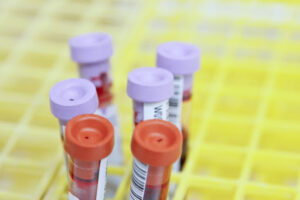Cooling a product to a temperature far below 0 at the perfect rate in a controlled rate freezer. Controlled rate freezers are indispensable cryogenic applications in various industries. We frequently supply cryogenic infrastructures that allow these freezers to function optimally.
What do these cryogenic infrastructures look like? What should be considered when installing a controlled rate freezer, and what types of controlled rate freezers are available? Read on for answers to these questions.
What is controlled freezing?
Various industries use freezers to keep products in optimal condition over an extended period of time. These industries include the food industry, the medical industry, and the pharmaceutical industry.
How these freezers function varies considerably. For example, some materials are frozen in well-known refrigerators like the ones we have in our homes. In contrast, other materials require just a little more care. Unregulated refrigeration can cause crystal formation, which causes cell damage.
As described in a blog by ThermoFisher, the larger the cells, the more important slow and controlled cooling is. Examples of materials that are often frozen in a controlled way include tissues, blood, cells, pharmaceutical test samples, and some food items.
For this purpose, controlled freezing in popular controlled-rate freezers has been developed. Controlled rate freezers are refrigeration systems that freeze a material at a perfect rate and temperature in order to prevent crystal forming – and thus damage. In most cases, these freezers contain a display with different programs on which you can program precisely how the freezing process should proceed.
Cryogenic controlled rate freezer
Controlled rate freezers come in different configurations: cryogenic with liquid nitrogen, or mechanical. Both types of freezers have their advantages and disadvantages, as described in our recent blog on sample storage.
Based on our expertise, we recognize the advantages of cryogenic controlled rate freezers for many customers. These freezers easily reach the extremely low temperature of -196°C and prove stable and reliable – even in the event of malfunctions or power failures, of course, backed by a backup battery.
Cryogenic controlled rate freezers are refrigeration systems connected to a tank or cryogenic storage dewar containing liquid nitrogen. The freezers are perfectly insulated and typically include a fan to distribute the liquid nitrogen evenly, a sensor to monitor temperature, and a display to program and monitor the freezing process.
Most cryogenic controlled rate freezers feature several preset freezing profiles and also allow the creation of customized profiles. The freezing process can be monitored on the freezer itself or on a computer with dedicated software. Exactly how this works depends on the type of controlled rate freezer and the user’s requirements.
A cryogenic controlled rate freezer by ThermoFisher
Installation and liquid nitrogen: advice and design
A cryogenic controlled rate freezer requires liquid nitrogen. And because every site is different, this supply involves several aspects.
As an experienced partner of various institutions in the food industry, the pharmaceutical industry, and the medical industry, Demaco regularly advises on the design of optimal cryogenic infrastructures for controlled rate freezers.
These projects typically involve the following:
- In the first meeting with the customer, we assess the end user’s requirements and the freezer’s design specifications. Various details are essential in that process, such as the flow (the number of liters per hour), the inlet pressure, and the required quality of the liquid nitrogen.
- Once all specifications are clear, we determine where vacuum-insulated transfer lines should be placed in the building to route the liquid nitrogen from the tank to the freezer. We also look at any additional safety measures or quality improvement products.
- Once the design is completed, price agreements are established. Then the project starts with the definitive measuring, followed by the production and assembly of the project.
Installation and liquid nitrogen: the infrastructure
What the final infrastructure will look like – as outlined above – depends on several factors. However, in many locations where a cryogenic controlled rate freezer is in use, we find the following components in place:
- A container or dewar filled with liquid nitrogen. Some liquid nitrogen users have a large storage tank on site. In contrast, others order a smaller tank or dewar from a gas supplier.
- A network of vacuum-insulated transfer lines that connect the tank or dewar to the freezer.
- Couplings to connect the vacuum-insulated pipe sections where necessary.
- Any quality-enhancing products such as automatic gas vents, degassers, subcoolers, or phase separators to optimize the quality of the liquid nitrogen and establish the proper operating pressure.
- Any additional safety measures include various valves, emergency shut-off valves, and bleed valves.
An infrastructure of vacuum-insulated transfer lines
Would you like to know more?
If you have questions about the installation and connection of a cryogenic controlled rate freezer or want to know more about Demaco’s products and services; feel free to contact us or take a look at our products and projects.






